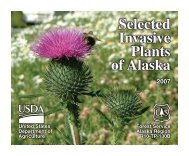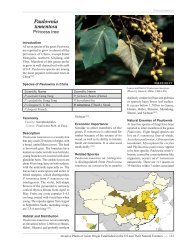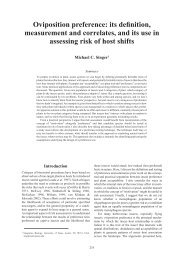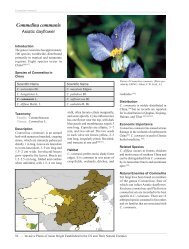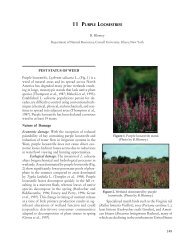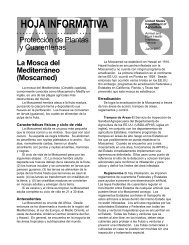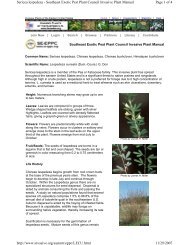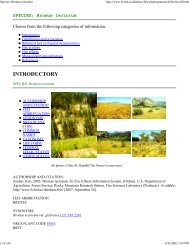A review of literature and field practices focused on ... - Invasive.org
A review of literature and field practices focused on ... - Invasive.org
A review of literature and field practices focused on ... - Invasive.org
Create successful ePaper yourself
Turn your PDF publications into a flip-book with our unique Google optimized e-Paper software.
A knotweed c<strong>on</strong>trol report authored by R<strong>on</strong> P. Crockett, a Technical Development<br />
Manager for M<strong>on</strong>santo (the manufacturer <str<strong>on</strong>g>of</str<strong>on</strong>g> glyphosate-based herbicides) referred to<br />
observed n<strong>on</strong>-target impacts:<br />
Observati<strong>on</strong>s made from limited applicati<strong>on</strong>s in 2003 <str<strong>on</strong>g>and</str<strong>on</strong>g> 2004 indicated that under<br />
some unusually heavy rainfall c<strong>on</strong>diti<strong>on</strong>s, n<strong>on</strong>-target plants developed herbicide<br />
symptomology. In the situati<strong>on</strong> where injury resulted, large numbers <str<strong>on</strong>g>of</str<strong>on</strong>g> plants had been<br />
treated outside labeling instructi<strong>on</strong>, <str<strong>on</strong>g>and</str<strong>on</strong>g> soils became saturated with winter rain events.<br />
It is likely that glyphosate was released from treated root systems (‘leaked-out’ <str<strong>on</strong>g>of</str<strong>on</strong>g> roots<br />
that were breaking down) <str<strong>on</strong>g>and</str<strong>on</strong>g> became available to neighboring plant roots sharing the<br />
same space in the water saturated soil soluti<strong>on</strong>.<br />
In soils that are light in texture, such as s<str<strong>on</strong>g>and</str<strong>on</strong>g>s, where fewer herbicide-binding sites exist<br />
to tie-up or bind the glyphosate to mineral soils making it herbicidal inactive; it is likely<br />
that these n<strong>on</strong>-target plants accumulated enough glyphosate to show herbicide injury<br />
symptoms into the following year. These symptoms included, late leaf emergence <str<strong>on</strong>g>and</str<strong>on</strong>g><br />
small misshaped leaves.<br />
These events would be predicted to occur in low <strong>org</strong>anic matter soils, or in mineral soils<br />
with fewer binding sites.<br />
These c<strong>on</strong>diti<strong>on</strong>s have not been seen in over 180,000 test site applicati<strong>on</strong>s in Oreg<strong>on</strong><br />
<str<strong>on</strong>g>and</str<strong>on</strong>g> Washingt<strong>on</strong>, but this c<strong>on</strong>cern outlines the need for applicators to pay close attenti<strong>on</strong><br />
to envir<strong>on</strong>mental c<strong>on</strong>cerns, as well as test site c<strong>on</strong>diti<strong>on</strong>s. Adherence to labeling<br />
instructi<strong>on</strong>, as well as safe herbicide use <str<strong>on</strong>g>practices</str<strong>on</strong>g> is always suggested for the safety <str<strong>on</strong>g>of</str<strong>on</strong>g><br />
the applicator <str<strong>on</strong>g>and</str<strong>on</strong>g> the envir<strong>on</strong>ment (Crockett, 2005).<br />
It seems that each c<strong>on</strong>trol method described here may potentially result in n<strong>on</strong>-target<br />
impacts. The potential for root/rhizome leakage <str<strong>on</strong>g>of</str<strong>on</strong>g> herbicide, especially in coarse soils<br />
with a high water table, should be c<strong>on</strong>sidered. The potential for impacts from any<br />
applicati<strong>on</strong> method must be part <str<strong>on</strong>g>of</str<strong>on</strong>g> the decisi<strong>on</strong> process in planning c<strong>on</strong>trol <str<strong>on</strong>g>of</str<strong>on</strong>g> knotweed.<br />
Management Recommendati<strong>on</strong>s (Best Management Practices) (from Soll, 2004)<br />
As for all weeds, there is no single “best” c<strong>on</strong>trol strategy for knotweed. The choices you<br />
make will hopefully be guided by underst<str<strong>on</strong>g>and</str<strong>on</strong>g>ing the ecology <str<strong>on</strong>g>of</str<strong>on</strong>g> the plant, your native<br />
system <str<strong>on</strong>g>and</str<strong>on</strong>g> the costs <str<strong>on</strong>g>and</str<strong>on</strong>g> effectiveness <str<strong>on</strong>g>of</str<strong>on</strong>g> the various treatment opti<strong>on</strong>s discussed here,<br />
your project goals <str<strong>on</strong>g>and</str<strong>on</strong>g> your (or your <strong>org</strong>anizati<strong>on</strong>’s) capacity to execute them. That said,<br />
the following recommendati<strong>on</strong>s are made in an attempt to provide guidance based <strong>on</strong><br />
combining financial, ecological, practical <str<strong>on</strong>g>and</str<strong>on</strong>g> legal c<strong>on</strong>siderati<strong>on</strong>s. Good luck.<br />
When to use manual methods<br />
If you have easy access to your site, [<str<strong>on</strong>g>and</str<strong>on</strong>g> you can commit to frequent periodic site visits<br />
for m<strong>on</strong>itoring <str<strong>on</strong>g>and</str<strong>on</strong>g> acti<strong>on</strong>,] c<strong>on</strong>sider employing manual/mechanical methods. [Small<br />
st<str<strong>on</strong>g>and</str<strong>on</strong>g>s may be the best c<str<strong>on</strong>g>and</str<strong>on</strong>g>idates for manual c<strong>on</strong>trol methods. Covering may hold<br />
potential for larger sites, but more informati<strong>on</strong> <strong>on</strong> l<strong>on</strong>g-term effectiveness is needed.] Be<br />
aware that repeated cutting tends to produce numerous small stems, which may make<br />
future treatment with stem injecti<strong>on</strong> more difficult. [Make sure that stem <str<strong>on</strong>g>and</str<strong>on</strong>g> root<br />
fragments are dealt with in a manner that prevents further knotweed spread.]<br />
24


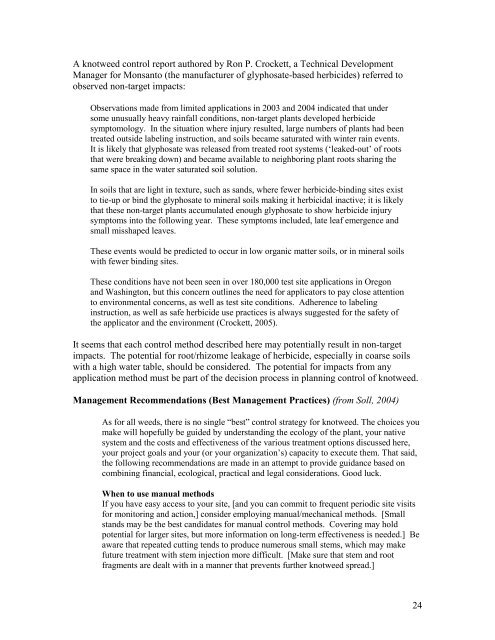

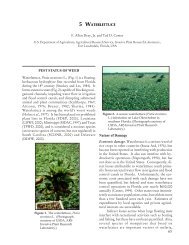

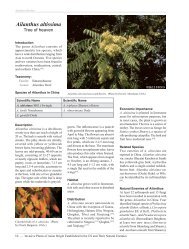
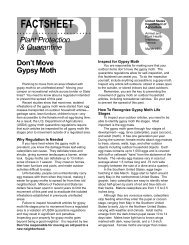
![A Guide to the Control and Management of Invasive Phragmites [PDF]](https://img.yumpu.com/27321025/1/190x190/a-guide-to-the-control-and-management-of-invasive-phragmites-pdf.jpg?quality=85)
